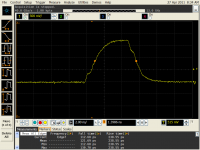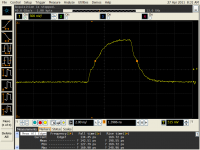Silver coax. I have to suggest you have been sold a bucket of goods. Sit back and think about the path your music has gone through before yo got it. If you were building some scientific instrument where you were the source of some ultra sensitive quantum sensor, maybe I could believe it.
Your amplifier has metal oxide resistors, copper traces and aluminum traces inside the chips.
Please take cbdb's comment to heart. It is well intentioned. We don't mind pushing the limits, but spend you effort and money on things that matter.
Your amplifier has metal oxide resistors, copper traces and aluminum traces inside the chips.
Please take cbdb's comment to heart. It is well intentioned. We don't mind pushing the limits, but spend you effort and money on things that matter.
cbdb, D-75's slew rate seems a bit faster. Does it mean something to you?
Whether it means something to you or cbdb is irrelevant. The "slew rate" (and I think you're misusing the term, I suspect you mean "rise time") doesn't matter to the receiver unless it's so slow that the transition gets "displaced." The waves would look more like triangles in that case- never actually seen one like that. spdif signals can look pretty poor to the human eye without affecting the receiver- one of the worst I've seen was a horribly ringy USB-spdif converter (Hiface) which nonetheless worked fine.
My mistake, "rise time" is the correct term.
It doesn't matter for the receiver for it's operation (if operation means keeping the PLL locked and data transmission uninterrupted).
The PLL gets squeaked by the jitter, FIFO attenuates the jitter only at HF, and LF jitter just passes thru. Everything is suboptimal and rather transparent from interface jitter...
Minimizing the rise time = minimizing the aperture uncertainty time of the receiver, which leads us to less "captured" noise at the decision point, resulting in less jitter.
Fast driver, proper transmission line is always better. No need to make it silver and gold-covered - just a good BNCs, cable and everything impedance-matched in 75ohm (for compatibility).
Or just thrash everything, throw a clock at the DAC, and sync the transport to it. It costs less than the "awesome audiophile interconnects".
It doesn't matter for the receiver for it's operation (if operation means keeping the PLL locked and data transmission uninterrupted).
The PLL gets squeaked by the jitter, FIFO attenuates the jitter only at HF, and LF jitter just passes thru. Everything is suboptimal and rather transparent from interface jitter...
Minimizing the rise time = minimizing the aperture uncertainty time of the receiver, which leads us to less "captured" noise at the decision point, resulting in less jitter.
Fast driver, proper transmission line is always better. No need to make it silver and gold-covered - just a good BNCs, cable and everything impedance-matched in 75ohm (for compatibility).
Or just thrash everything, throw a clock at the DAC, and sync the transport to it. It costs less than the "awesome audiophile interconnects".
Last edited:
Merlin, as I said Imeant no disrespect
The scope shots dont have enough resolution to detrermine rise time change,
and even then a slight decreasing of the rise time (within certain parameters)
would not be detrimental to the signal but probably beneficial.
As to the rest, as stated its a digital signal with a bit of overshoot and ringing
nothing to worry about.
Heres some links to some (if not thee) top guys for digital signal integrity.
Signal Consulting, Inc. - Dr. Howard Johnson
beTheSignal.com
Speeding Edge consultants specialize in high-speed PCB and system design disciplines
Part of the Hiface problem with ringing was a ridiculasly fast rise time for the signal frequency, increasing the high frequency harmonic content of the signal and causing more problems, than it solved.
The scope shots dont have enough resolution to detrermine rise time change,
and even then a slight decreasing of the rise time (within certain parameters)
would not be detrimental to the signal but probably beneficial.
As to the rest, as stated its a digital signal with a bit of overshoot and ringing
nothing to worry about.
Heres some links to some (if not thee) top guys for digital signal integrity.
Signal Consulting, Inc. - Dr. Howard Johnson
beTheSignal.com
Speeding Edge consultants specialize in high-speed PCB and system design disciplines
Part of the Hiface problem with ringing was a ridiculasly fast rise time for the signal frequency, increasing the high frequency harmonic content of the signal and causing more problems, than it solved.
A few metres of cable causes a little high frequency jitter, which is removed by the receiver PLL - that is what it is designed to do. Low frequency jitter comes from the CD player crystal oscillator, and neither the cable nor the PLL can do anything about that. Too fast a rise time creates problems, as would too slow a rise time.
All these people obsessing about silver cables etc. (even with RCAs!!) would do better to learn about data slicers, PLLs and low noise crystal oscillators. If any improvement is needed, which is unclear to me, that is where the improvement would lie. It seems standard 'audiophool' logic to concentrate on the one thing which makes no difference (the cable), presumably on the grounds that it is easy to show a meaningless change on an oscilloscope trace.
All these people obsessing about silver cables etc. (even with RCAs!!) would do better to learn about data slicers, PLLs and low noise crystal oscillators. If any improvement is needed, which is unclear to me, that is where the improvement would lie. It seems standard 'audiophool' logic to concentrate on the one thing which makes no difference (the cable), presumably on the grounds that it is easy to show a meaningless change on an oscilloscope trace.
I had a friend once who said " Anything under 1 MHZ is considered DC. ". After dealing with C band microwave (4300 MHZ) (Radio Altimeters) for 8 years; I believe him.
In my opinion it is best to use the highest impedance (lowest capacitance) cable if you are going to use coax for audio purposes.
In my opinion it is best to use the highest impedance (lowest capacitance) cable if you are going to use coax for audio purposes.
Last edited:
Maybe something like this (13pF-ft).
http://www.gore.com/MungoBlobs/584/377/CXN1458c.pdf
http://www.gore.com/MungoBlobs/584/377/CXN1458c.pdf
Last edited:
- Status
- This old topic is closed. If you want to reopen this topic, contact a moderator using the "Report Post" button.
- Home
- Design & Build
- Parts
- Looking for silver digital coax

